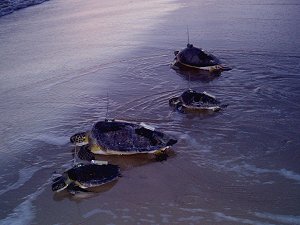Grant: 03-R10R
Project Title: Migration vs. Hibernation - Overwintering Strategies of Juvenile Sea Turtles in the Florida Panhandle
Project Manager: Dr. Ray Carthy
Organization: University of Florida - Florida Cooperative Fish & Wildlife Research Unit (Research and Educational Institute)
Grant Amount: $24,809.00
Completion Date: 2004-07-26
Summary: This project will enhance conservation efforts of several sea turtle species by providing information on habitat use, population ecology, and seasonal movements of juvenile sea turtles in the northeastern Gulf of Mexico. We will test the hypothesis that because of their slow maturation and long life span, juvenile sea turtles do not display migration patterns at earlier juvenile stages.  Results: Satellite and sonic telemetry were used to investigate the initial movement behavior and navigational cues used by juvenile green sea turtles (Chelonia mydas) following displacement in the Gulf of Mexico. Four juvenile green turtles were found cold-stunned near the southwest end of St. Joseph Bay, Florida on 11 January, 2004, rehabilitated, and fitted with satellite and sonic transmitters. Turtles were released 4 days later into the Gulf of Mexico, just south of the Bay (pictured at right). All four turtles followed very similar paths, orienting ESE along approximately 90 km of coastline, with offshore ranges of <5 km - 60 km. All turtles reversed their eastern headings and returned to the southern end of St. Joseph Bay within 77 days of being released, and the fourth transmitter ceased to provide data within the southern end of the Bay. These initial movement data, gathered over 160 days, suggest that juvenile green sea turtles may exhibit certain site fidelity or homing characteristics. (Authors: R. Scarpino, E. McMichael, D. Bagley, R. Carthy and J. Seminoff)
Results: Satellite and sonic telemetry were used to investigate the initial movement behavior and navigational cues used by juvenile green sea turtles (Chelonia mydas) following displacement in the Gulf of Mexico. Four juvenile green turtles were found cold-stunned near the southwest end of St. Joseph Bay, Florida on 11 January, 2004, rehabilitated, and fitted with satellite and sonic transmitters. Turtles were released 4 days later into the Gulf of Mexico, just south of the Bay (pictured at right). All four turtles followed very similar paths, orienting ESE along approximately 90 km of coastline, with offshore ranges of <5 km - 60 km. All turtles reversed their eastern headings and returned to the southern end of St. Joseph Bay within 77 days of being released, and the fourth transmitter ceased to provide data within the southern end of the Bay. These initial movement data, gathered over 160 days, suggest that juvenile green sea turtles may exhibit certain site fidelity or homing characteristics. (Authors: R. Scarpino, E. McMichael, D. Bagley, R. Carthy and J. Seminoff)